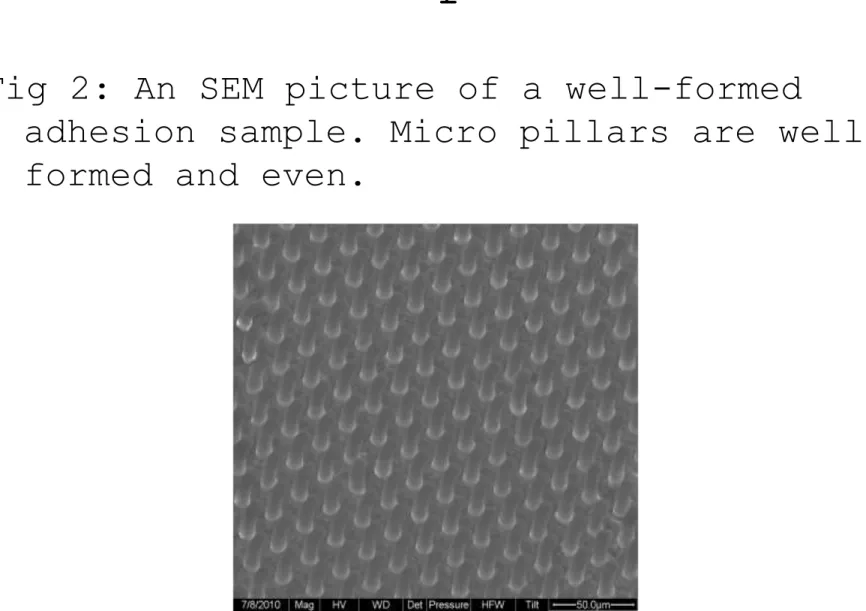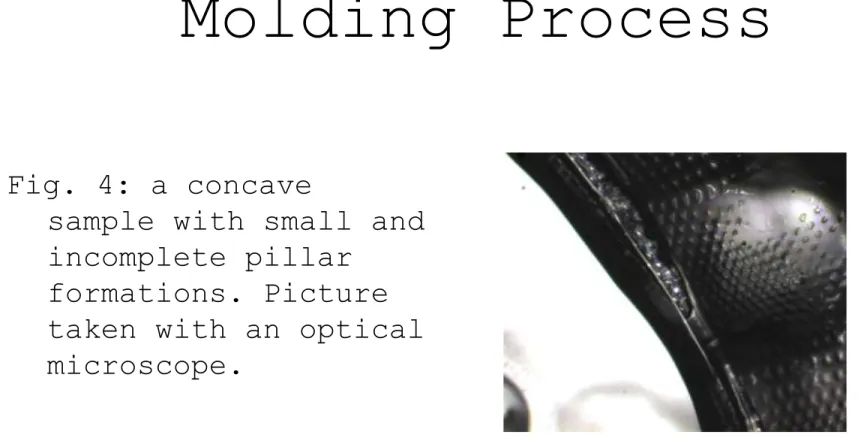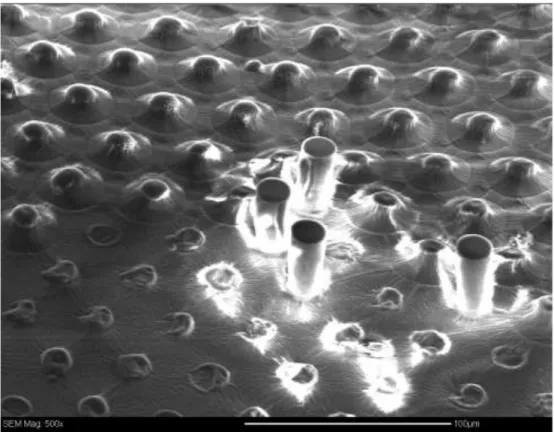Creating Adhesive Samples of
Methacrylate based Shape Memory
Polymers with Bioinspired
Micropatterned Surfaces
Shape Memory Polymers
– A polymer with the
ability to be heated and cooled through its
transition stage to retain a new shape, and return to its original shape upon reheating to the
transition point.
– Using cross linkers and linear builder molecule chains, Shape Memory Polymers (SMPs) retain their shape due to
chemical, rather than physical, properties.
Bioinspired Micropatterned
Surfaces
– Micron-sized pillars are used by many insects and reptiles to adhere and then easily detach themselves from most types of surfaces
– The remarkable properties of these micro sized pillars (or hairs) is based on a complex physical geometry, chemistry, and mechanical stiffness that draws on intermolecular forces to adhere the exterior to seemingly impossible angles and surfaces.
1 μm = 0.001 mm 5 μm 50 μm
1 μm
• Gecko feet have small hairs called setae
• Fibrillar structures (i.e. long and skinny) that fan into smaller spatula
• Geometrically very compliant allowing for good contact with rough surfaces • Cumulative van der Waals forces of all spatula enough to support gecko
Purpose
– To make micropatterned surfaces
using SMPs, using their
dramastic change in storage
modulus with temperature to
create ‘switcheable adhesion’.
– Preliminary tests using the
surface in Figure 2
demonstrated this.
Purpose
Fig 2: An SEM picture of a well-formed
adhesion sample. Micro pillars are well
formed and even.
Micropatterned Switcheable
Adhesive Surfaces
– Using photolithographic forms, it is
possible to mold a field of similar
sized hairs
– Using shape memory polymers, a
surface would be soft and adhesive at
50 degrees Celsius, and to hard to be
adhesive at room temperature (or
below).
– By using shape memory polymers, the
structure and adhesive ability would
not be compromised by repeated
Dynamic Mechanical
Analyzer Tests
– To test changes is phases, DMA tests were run of The SMP consisted of crosslinkers poly(ethylene glycol)
dimethacrylate (PEGDMA with a molecular weight of Mn=550 and di(ethylene glycol) dimethacrylate (DEGDMA) 95%, and linear builder tert-Butyl acrylate (98%) (tBA). The
crosslinker was a mix of a 7:3 ratio of PEGDMA to
DEGDMA, and the photoinitiator or thermal initiator used was added as 0.1% of the total weight. The ratio of
crosslinker to tBA was changed to range from 1:99 to 80:20.
– Finding a SMP with a storage modulus between 1 and 10 MPa and a glass transition phase around 50-60̊C
– A ratio of 20:80 crosslinker to tBa linear building was found to show the desired qualities and was used in all subsequent research
Dynamic Mechanical
Analyzer Tests
80:20 60:40 40:60 20:80 10:90 1:99 80:20 60:40 40:60 20:80 10:90 1:99Figure 2 (b) Shows the Tan Delta graphs of various SMP ratios. The high point on each curve represents the glass transition point, Tg.
Figure 2 (a) shows graphs of the average storage modulus for
various SMP ratios of crosslinker to tBA in dark, with light grey lines representing individual tests that were used to obtain the average data.
Sto rag e Mo dul us ( MP a )
Molding Process
– Photolithographic silicate plates
with the micropillared surface were
created by our collaborators at the
Leibieniz institute for New Materials
in Saarbrucken, Germany.
– PDMS (Sylgard-184 silicon elastomer)
molds were created from the plates,
and were salinized before use using a
Nalgene desiccator with a vial of
30-50µl 1H, 1H, 2H,
2H-Perflourooctyltrichlorosilane and 2
ml n-Hexane puriss
Molding Process
A new molding process had to be
developed
– 6+ processes tried
–Greases
–Caulking
–UV light setup
–Attachment methods
–Glass slide set-up
–Thermal/UV Curing
Molding Process
Caulking Spacer
Glass Slide
Glass Slide
PDMS Mold
Molding Process
Fig. 4: a concave
sample with small and
incomplete pillar
formations. Picture
taken with an optical
microscope.
Molding Process
Fig 6: SEM pictures
showing several well-formed pillars in fields of torn
pillars. Pillars are also shown that tore off and fell onto surface.




